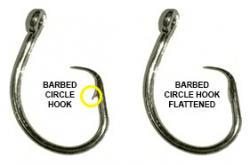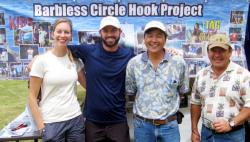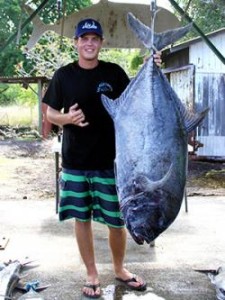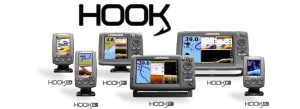Missouri Paddlefish Season Opens March 15
Editor’s Note: Here’s an interesting look at a sport many of us have never tried, but it’s apparently one of the few ways to harvest the giant “spoonbills” that populate many of our big Midwestern rivers and lakes.
MDC makes paddlefish snagging possible through annual stockings of fingerlings.
Missouri’s annual spring paddlefish snagging season is a popular pastime for thousands of anglers. The state’s major paddlefish snagging waters include Lake of the Ozarks, Truman Lake, and Table Rock Lake with the season running March 15 through April 30. The season for the Mississippi River is March 15 through May 15 with a fall season of Sept. 15 through Dec. 15.
Also known as “spoonbills” because of the shape of their snouts, paddlefish take seven or eight years to grow to legal size. The fish feed on plankton and other microscopic prey. These filter feeders therefore do not take bait from hooks and must be snagged using large hooks that catch in the mouth, gills or other areas of their bodies.
The success of paddlefish snagging is dependent on weather conditions, primarily water temperature and flow.
“The best snagging conditions occur when water temperature reaches 50 to 55 degrees and there is an increase in water flow,” MDC Fisheries Management Biologist Trish Yasger said. “This prompts them to move upstream to spawn. We don’t usually see a lot of big fish being caught on opening day. Harvest early in the season is typically dominated by local fish and small males with the occasional large female. As water temperature and flow increase, you will start seeing more of the larger females.”
Stocking Efforts
The Missouri Department of Conservation (MDC) makes paddlefish snagging possible in the Show-Me State through annual stocking of up to 38,000 fingerlings raised at Blind Pony Hatchery near Sweet Springs. The fingerlings are released into Lake of the Ozarks, Truman Lake and Table Rock Lake, plus the Black River. The annual stocking is necessary because dams and other barriers to spawning areas have eliminated sustainable natural reproduction in the lakes.
“Without annual stocking by MDC staff, this popular pastime and food source would go away,” said Yasger. “And we need help from snaggers to learn more about and to better manage this popular game fish.”
Yasger added that MDC released an especially large number of fingerlings into Lake of the Ozarks, Truman Lake, and Table Rock Lake in 2008. The more than 164,000 fingerlings released are now eight years old and should start providing good numbers of fish for snaggers to harvest.
Snag A Tag – Get A Reward
MDC is beginning its second year in a five-year tagging project to help monitor paddlefish numbers and improve species management. Department staff are placing metal jaw tags on up to 6,000 paddlefish netted in Lake of the Ozarks, Truman Lake, and Table Rock Lake and up to 1,000 netted from the Mississippi River. Yasger encourages all snaggers to help out by reporting tagged paddlefish and to NOT remove tags from undersized paddlefish.
“We will send a special ‘I caught a Missouri paddlefish!’ t-shirt to each snagger who returns or reports their first tag on a legal-sized fish,” Yasger explained. “All returned and reported tags will be placed into an annual drawing for cash prizes with a grand prize of $500.”
Tags or photos of tags from harvested paddlefish must be submitted for rewards. Snaggers must include the following information with each tag:
Date caught
Location of catch including reservoir or river, mile marker, and county
Tag number
Fish length from eye to fork of the tail
Snagger’s name and complete address
Report tags by calling MDC at 573-579-6825 with the information, or mail the information with the flattened tag to: Missouri Department of Conservation, 3815 East Jackson Blvd., Jackson, MO 63755. Learn more about the tagging project from MDC online at http://on.mo.gov/1VA1E6B.
Report Transmitters
MDC biologists are also implanting ultrasonic transmitters in adult paddlefish at Truman Lake, Lake of the Ozarks, Table Rock Lake, and the Mississippi River to track their movements and gain other important information. MDC asks that all snaggers who harvest fish with a transmitter to report it by calling 573-579-6825 or by e-mailing Trish Yasger at Trish.Yasger@mdc.mo.gov. It is important to return transmitters so they can be implanted in other fish.
Help smaller fish survive
Yasger reminds snaggers to help undersized snagged fish survive to grow larger.
“Do not land paddlefish with gaffs. This can fatally injure sublegal fish. Use large landing nets,” she said. “Remove hooks carefully and get sublegal fish back into the water as quickly as possible. Wet your hands before handling fish and avoid excessive handling. Do not pass them around for photos and hold fish firmly to avoid dropping them. Never put fingers in the gills or eyes.”
Regulation Requirements
The state’s major paddlefish snagging waters include Lake of the Ozarks, Truman Lake, and Table Rock Lake with the season running March 15 through April 30. The season for the Mississippi River is March 15 through May 15 with a fall season of Sept. 15 through Dec. 15.Unless exempt, anglers must have a current fishing permit to snag or to operate a boat for snaggers. The daily limit is two paddlefish and snaggers must stop snagging after obtaining the daily limit on Lake of the Ozarks and Truman Lake and their tributaries, and the Osage River below Bagnell Dam. The minimum legal body length for paddlefish at Lake of the Ozarks, Truman Lake, Table Rock Lake, and their tributaries is 34 inches, measured from the eye to the fork of the tail. The minimum legal body length is 24 inches on the Osage River below Bagnell Dam and in other Missouri waters. All paddlefish under the legal minimum length must be returned to the water unharmed immediately after being caught.
The Wildlife Code of Missouri requires the head, tail, and skin to remain attached to all paddlefish while on the water so paddlefish should not be cleaned until off of the water. Also, extracted paddlefish eggs may not be possessed while on waters of the state or adjacent banks and may not be transported. Paddlefish eggs may not be bought, sold or offered for sale. Additionally, paddlefish or their parts, including eggs, may not be used for bait.
Learn more about Missouri’s official aquatic animal, regulations, snagging reports, and more at http://huntfish.mdc.mo.gov/fishing/species/paddlefish.
















